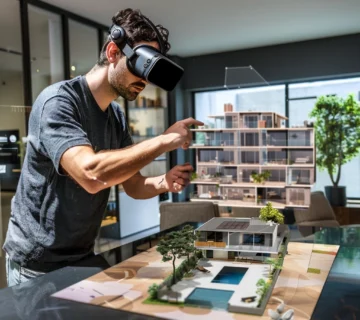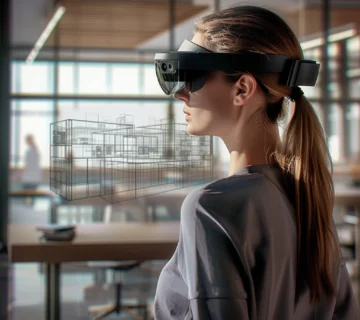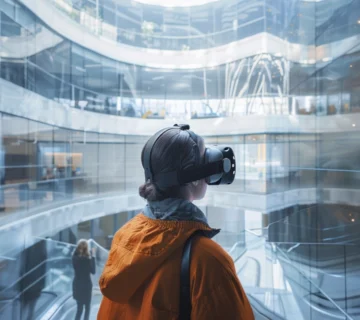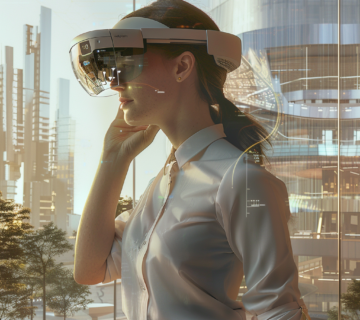“How to Bridge the Gap Between People and Buildings with Interactive Architecture: Innovative Solutions”
Introduction
In the dynamic world of architecture, a new era is dawning, one that is defined by the seamless interaction between people and the built environment. The concept of interactive architecture is leading this transformation, acting as the bridge connecting individuals to the cutting-edge designs of the new generation of building architecture. In this article, we will explore how interactive architecture is shaping the future, enhancing user experiences, and redefining the way we interact with our surroundings.
The Evolution of Interactive Architecture
Interactive architecture represents a fundamental shift from traditional, static building design to the new era of digital architecture. It focuses on creating dynamic, responsive structures that engage with the people who inhabit or pass through them. These innovative designs incorporate various technologies and elements to facilitate interaction, ensuring that architecture is not just a backdrop but an active participant in our daily lives.
Interactive architecture stands at the forefront of a significant paradigm shift in the field of building architecture. Unlike the static and passive structures of the past, interactive architecture has ushered in a new era where buildings are not merely inert constructions but vibrant, responsive entities that actively engage with the individuals who interact with them. This evolution signifies a departure from the conventional idea of exterior architecture design as a mere backdrop, and instead positions it as a dynamic and participatory element in our everyday lives.
6 Key Elements of Interactive Architecture
This transformative shift can be better understood by delving into some of its key aspects:
-
Sensory Technologies:
Interactive architecture often employs a range of sensory technologies, such as motion sensors, touch-sensitive surfaces, and responsive lighting systems. These elements enable buildings to react to the presence and movements of people, enhancing safety, convenience, and aesthetics.
-
Dynamic and Responsive Structures:
Interactive architecture is characterized by its inherent dynamism. Rather than remaining static, buildings and spaces are designed to adapt, respond, and evolve in real-time. This dynamism is achieved through the integration of various technologies and architectural elements that enable buildings to react and adjust to changing circumstances, be it environmental conditions, user movements, or specific needs.
-
User-Centric Design:
In the evolution of interactive architecture, the emphasis is on the user. Designers prioritize creating futuristic architecture that caters to the unique needs and preferences of individuals who inhabit or pass through them. This human-centric approach results in environments that are not only functional but also deeply attuned to the comfort and satisfaction of their users.
“This is the phase in which you immerse yourself in your users’ lives to gain a better understanding of who they are. Observe and ask questions to see things from their point of view. Identify your biases and assumptions so you can deviate from them if they don’t align with your users’ reality.”
New generation building architecture places people at the center of the design process. Interactive spaces are tailored to the needs and preferences of their users, promoting comfort and user engagement.

-
Sustainability and Efficiency:
Contemporary architecture design is increasingly defined by the imperative of sustainability. Interactive architecture embraces this ethos by incorporating energy-efficient systems, eco-friendly materials, and responsive designs. This commitment to sustainability not only minimizes the environmental footprint but also ensures that buildings operate in an energy-efficient manner, promoting resource conservation and reducing costs.
Interactive architecture aligns with the values of the new generation of architects who prioritize sustainable architecture. Energy-efficient systems and responsive designs reduce environmental impact while creating healthier, more efficient spaces.
-
Technology Integration:
Interactive architecture seamlessly integrates cutting-edge technologies to enhance the overall experience. The Internet of Things (IoT) and Artificial Intelligence (AI) play pivotal roles in this integration, enabling buildings to anticipate and respond to users’ needs. For example, smart climate control systems can adapt to temperature preferences, responsive lighting systems can optimize illumination, and security systems can enhance safety, all while minimizing energy consumption.
The integration of cutting-edge technologies like the Internet of Things (IoT) and Artificial Intelligence (AI) allows buildings to anticipate and fulfill users’ needs. This can range from smart climate control to adaptive lighting and security systems.
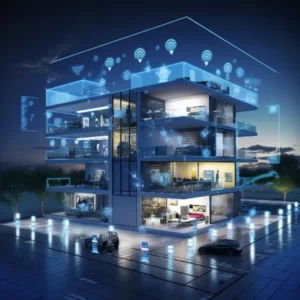
-
Adaptability and Resilience:
One of the most significant aspects of interactive architecture is its adaptability. These buildings have the capacity to evolve and adjust over time, aligning with changing user requirements and external factors. This adaptability ensures that architectural designs remain relevant, functional, and appealing well into the future.
In other words, the evolution of interactive architecture signifies a pivotal moment in the history of building design. It redefines the relationship between people and their physical surroundings by introducing an active and responsive element to architecture design. This transformative approach not only enhances the user experience but also contributes to more sustainable architecture, efficient, and adaptable buildings. As we continue to embrace these innovative principles, the architectural landscape of the future holds the promise of becoming more dynamic, interactive, and deeply connected to our daily lives.
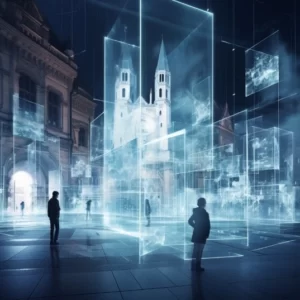
Enhancing User Experiences in architecture design:
Interactive architecture enriches the user experience in numerous ways. It empowers individuals to control and personalize their environments, fostering a sense of empowerment and well-being. For instance, responsive facades can optimize natural light and temperature, creating spaces that adapt to different seasons and preferences. Interactive elements also have the potential to make urban spaces more engaging, interactive, and user-friendly, contributing to the well-being of the community.
Redefining Urban Spaces:
The new generation of building architecture, with the help of interactive design, is redefining urban spaces. Public areas, transportation hubs, and Exterior architecture design of city centers are becoming more than just static structures; they are evolving into dynamic, adaptable spaces that cater to the diverse needs of their inhabitants. Interactive architecture is facilitating this transformation by infusing these spaces with innovation and adaptability.
Interactive Architecture blurs the line between digital architecture and reality:
Interactive architecture blurs the line between the physical and digital worlds. It involves the incorporation of responsive elements within architectural designs, allowing buildings and spaces to interact with their users. This interactivity can take various forms, including sensor-driven lighting systems, kinetic facades that adapt to environmental conditions, or responsive installations that engage occupants in playful or informative ways. The main idea is to create dynamic and adaptive spaces that respond to the needs and desires of the people within them. With the help of sensors, embedded technologies, and real-time data processing, architects can design spaces that not only look futuristic but also offer a highly engaging and personalized experience. Interactive architecture not only transforms the aesthetics of buildings but also enhances functionality and usability in an innovative way.
Conclusion
Interactive architecture is the driving force behind the new generation of building architecture, promising a Futuristic architecture where buildings are not just structures but active participants in our lives. As technology continues to advance, we can expect to see even more innovative applications of interactive architecture, bridging the gap between people and their surroundings. This exciting trend is fostering a dynamic, user-centric, and sustainable approach to architecture, reshaping the way we live, work, and experience the world around us. As the bond between individuals and the built environment continues to strengthen, the future of architecture looks brighter and more interactive than ever before.





